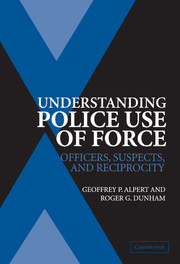Book contents
- Frontmatter
- Contents
- Acknowledgments
- Introduction: The Context of Police Use of Force
- 1 Police Use of Force: The History of Research
- 2 The Crucial Element: Finding Research Sites
- 3 Findings from Miami-Dade Police Department Study
- 4 The Sequential Steps in Use-of-Force Incidents in the Miami-Dade Police Department
- 5 Miami-Dade Police Department: Inconsistencies between Officer and Suspect Accounts of the Use of Force
- 6 Findings from Prince George's County Police Department
- 7 Findings and Summary
- 8 Explaining Police Use of Force: The Breakdown of an Authority Maintenance Ritual
- Appendix: Frequencies of Force Sequences for First through Tenth Actions
- Index
5 - Miami-Dade Police Department: Inconsistencies between Officer and Suspect Accounts of the Use of Force
Published online by Cambridge University Press: 14 July 2009
- Frontmatter
- Contents
- Acknowledgments
- Introduction: The Context of Police Use of Force
- 1 Police Use of Force: The History of Research
- 2 The Crucial Element: Finding Research Sites
- 3 Findings from Miami-Dade Police Department Study
- 4 The Sequential Steps in Use-of-Force Incidents in the Miami-Dade Police Department
- 5 Miami-Dade Police Department: Inconsistencies between Officer and Suspect Accounts of the Use of Force
- 6 Findings from Prince George's County Police Department
- 7 Findings and Summary
- 8 Explaining Police Use of Force: The Breakdown of an Authority Maintenance Ritual
- Appendix: Frequencies of Force Sequences for First through Tenth Actions
- Index
Summary
in addition to the interactive and sequential analyses of the use of force in MDPD (Chapters 3 and 4, respectively), we also undertook an analysis of officer and citizen versions of situations in which force was used. This innovation serves several purposes beyond the limited empirical findings the research yields, although these findings do, to a large extent, reinforce those found in Chapters 3 and 4. First, it underscores the importance of unbiased reporting, given the significant rates of inconsistency between officer and suspect versions of events. Second, it demonstrates the unavoidably self-serving nature of reporting by those involved, whether officers, suspects, or citizens. This is of particular relevance in a social climate where lawsuits abound. Third, and perhaps most important for the purposes of this book, this groundbreaking approach indicates that there is a clear need for a conceptual framework with which to assess (and research) the use of force including both the officer's and suspect's actions. We propose such a framework in the final chapter.
In addition to interactional and sequential analyses, data were also collected on officer and suspect versions of the same incidents. We compared the versions on three occasions using three different data points. The first sample was generated from the agency's official control-of-persons reports, which were the basis of the data set analyzed in Chapter 4. These data served as a benchmark, allowing us to ascertain where there were differing versions of the same event.
- Type
- Chapter
- Information
- Understanding Police Use of ForceOfficers, Suspects, and Reciprocity, pp. 124 - 134Publisher: Cambridge University PressPrint publication year: 2004



